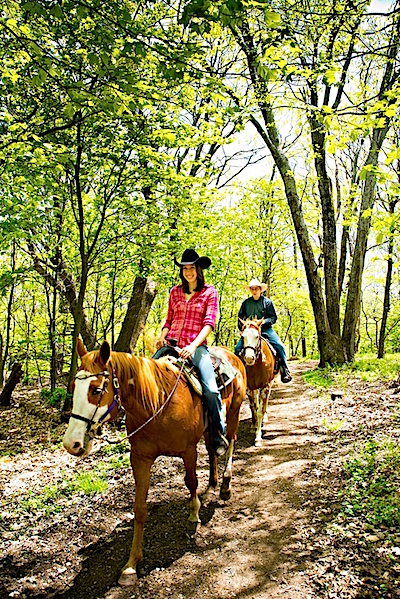
Shenandoah National Park has miles of trail to explore from the back of a horse. Bring your own, or sign on for a trail ride at Skyland Stables/Delaware North at Shenandoah National park photo
As a longtime resident of northern Virginia, I feel like I know Shenandoah National Park fairly well. I’ve driven the 105-mile length of Skyline Drive several times, stayed in and near the park, and spent many weekends hiking there. And yet I’ve never experienced the park from the back of a horse...until now.
It was a late spring day, and my husband and I had arrived at Skyland Stables where we were planning to take a guided horseback tour through one of the park’s most scenic and historic areas. I’ve ridden horses before, but in fairly flat, manicured locations. Riding in mountainous terrain is a different story, and I was both excited and a little nervous.
Shenandoah is just one of several national parks (including monuments, battlefields and other sites) that offer guided horseback tours and miles of open bridle trails to park visitors. Whether you’re riding along the historic carriage roads at Acadia, climbing toward the snowy peaks of Rocky Mountain, or descending into the depths of Grand Canyon, horseback riding allows you to get out of the car, away from the crowds, and into a park’s interior without the effort that hiking or backpacking requires. It also brings riders in touch with a long-lost mode of travel across these majestic landscapes.
Located off of Skyline Drive at Milepost 42.5, Skyland Stables has been a part of Shenandoah for more than 75 years. Newly renovated in 2014, the stables have 1- and 2 1/2-hour guided horseback rides for older children and adults, as well as pony rides for little ones five and under. The rides are appropriate for people who are experienced in the saddle as well as relative greenhorns like me. For those who have their own steeds, Shenandoah has about 200 miles of trails open to equestrians. They range from smooth gravel paths to steeper, more challenging routes.

A ride through the park is a great way to explore Shenandoah/Delaware North at Shenandoah photo
On the day of our visit, we were immediately transported away from our urban life when we spotted the stable: three original wooden structures arranged in a U-shape that house 12 horses. Our wrangler gave us a brief introduction and safety-talk: no open-toed shoes, and stay in a single file and on the trail. Then we were up on our horses for a one-hour ride. My horse was a light brown beauty with a white nose, and it moved gracefully and deliberately. I felt comfortable in the saddle.
After we crossed Skyline Drive, our group of six riders moved onto an east-bound trail and down the mountainside into Whiteoak Canyon and the Limberlost area of the park. A hush fell over the group as we were lulled by the rhythmic clopping of hooves on the trail. Along the way, we passed a rocky stream, imposing stands of lush trees, and quiet meadows. We ambled along slowly, the warm breeze in our faces, birds chirping in the air, and small mammals rustling through the brush. Deer, bobcat and even black bears have all been spotted on these rides, although I’m not lucky enough today to see any of them myself.
An old apple orchard reminds us that generations of mountain people once made their homes in this Shenandoah landscape, long before the park was created. Too soon, we returned to the stable, refreshed and invigorated.
“Horseback riding has a long tradition at Skyland,” says Nick Smith, the general manager of the Skyland Resort, which also includes a restaurant, gift shop, and lodging. “When you take one of our tours, you’re not only getting an interpretive message about the park and its history, but the horse does all the work.”
Ride on.
Scenic Summits
National park scenery is varied and stunning when seen from horseback. At Glacier National Park in Montana, for example, Swan Mountain Outfitters guides horseback tours that range from an hour to a whole day or even overnight (their Cowboy Cookout rides also include a steak dinner).
As in Shenandoah, Glacier’s history is tied to horse travel. The park’s earliest visitors arrived via the Great Northern Railroad, and then spent days or weeks crossing the park in the saddle. According to Hannah Neel, Swan Mountain’s assistant general manager of operations,“Horseback riding is the most historically accurate mode of travel through the park.”
Some of the trails have quite a bit of elevation change. They take you up into the high country to show off cerulean mountain lakes, rugged peaks, and old-growth forest. Elk, deer, mink, mountain lions, and grizzly bears are often spotted on these trails.
Despite the sometimes challenging terrain, riders do not need any experience finding a horse tour that suits their interests. “We’ve taken people out who have never even seen a horse in person before,” Neel says. “Each of our horses is unique, and each of our experiences is unique. Our goal is to help our clients to value Glacier National Park and keep it protected.”









Add comment